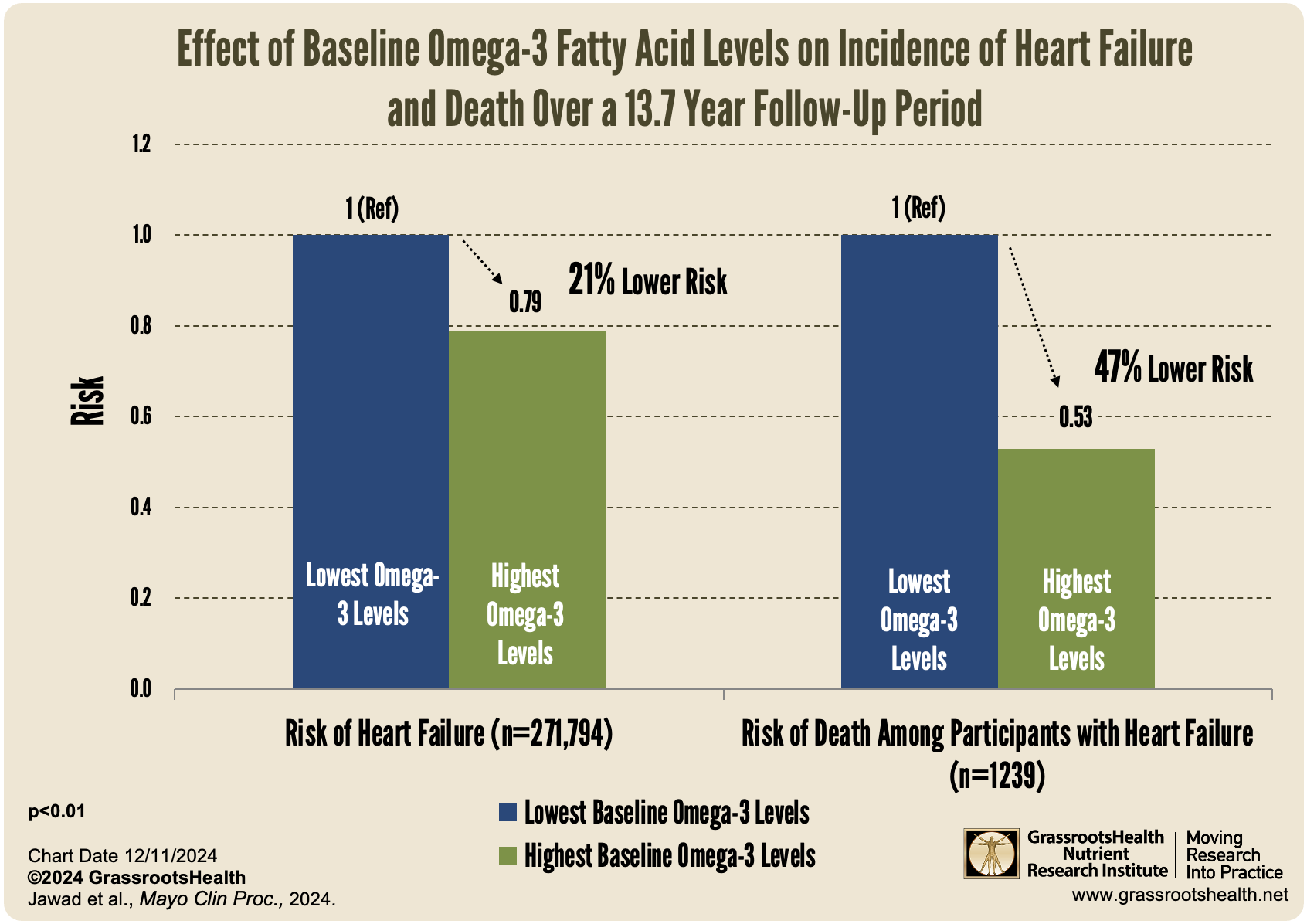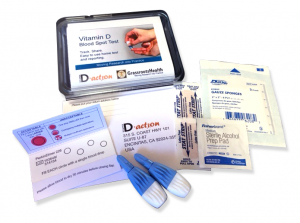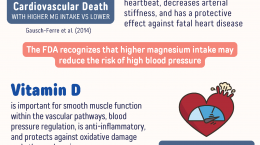Published on December 12, 2024
New study finds 21% lower risk of heart failure and almost 50% lower risk of death among individuals with the highest blood levels of omega-3 fatty acids compared to the lowest levels
Key Points
- Several lesser known findings from the VITAL trial included a 50% reduction in death from heart attack, an overall 25% reduced risk of heart attack, and a 77% reduced risk of heart attack specifically among African Americans, among those taking omega-3 fatty acids compared to placebo
- A new study found an inverse association between baseline omega-3 blood levels and the occurrence of heart failure during the follow-up period – those with the highest blood levels of omega-3 fatty acids had a 21% lower incidence of heart failure. There was also a 47% reduced risk of death among participants who had heart failure at the beginning of the study.
- Although similar, associations between heart failure were strongest when comparing levels of non-DHA omega-3 fatty acids compared to DHA and total omega-3s – suggesting that EPA levels might have a stronger effect on cardiovascular disease and heart failure than other omega-3 fatty acids
 A large percentage of adults in the United States are at high risk for heart disease and factors contributing to the risk of heart failure, including hypertension, diabetes, and obesity. Previous studies have found that omega-3 fatty acids are beneficial for heart health and may reduce the risk of death from cardiovascular events. For example, the VITAL trial, which involved both vitamin D and omega-3s and was primarily focused on cancer and cardiovascular health, was a randomized, double blind, placebo-controlled clinical trial that included 25,871 participants. All participants were free of any cancer and cardiovascular disease diagnoses at baseline; some of the findings from the data included a 50% reduction in death from heart attack, an overall 25% reduced risk of heart attack, and a 77% reduced risk of heart attack specifically among African Americans, among those taking omega-3 fatty acids compared to placebo.
A large percentage of adults in the United States are at high risk for heart disease and factors contributing to the risk of heart failure, including hypertension, diabetes, and obesity. Previous studies have found that omega-3 fatty acids are beneficial for heart health and may reduce the risk of death from cardiovascular events. For example, the VITAL trial, which involved both vitamin D and omega-3s and was primarily focused on cancer and cardiovascular health, was a randomized, double blind, placebo-controlled clinical trial that included 25,871 participants. All participants were free of any cancer and cardiovascular disease diagnoses at baseline; some of the findings from the data included a 50% reduction in death from heart attack, an overall 25% reduced risk of heart attack, and a 77% reduced risk of heart attack specifically among African Americans, among those taking omega-3 fatty acids compared to placebo.
New Study Confirms Previous Findings of Omega-3 Benefits for Heart Health
A new study by Jawad et al. analyzed data from the UK Biobank, including participants who had baseline measurements of serum omega-3 fatty acids. Participants were followed for an average of 13.7 years from baseline to study conclusion.
One of their analyses included 271,794 individuals who were free of heart failure at the beginning of the study. They found an inverse association between baseline omega-3 blood levels and the occurrence of heart failure during the follow-up period – meaning that as blood levels of omega-3 fatty acids increased, the incidence of heart failure decreased.
Specifically, there was a 21% lower risk among those with the highest omega-3 levels compared to those with the lowest levels ( p<.001).
Another analysis included 1239 participants with prevalent heart failure at the time of measuring baseline omega-3 levels. Of these participants, 44% died during the follow up period, of which 46% were due to cardiovascular events. The risk for all-cause mortality and death due to cardiovascular events among this group of participants was reduced by approximately 50% for those with the highest blood levels of omega-3 fatty acids verses the lowest (HR: .53, p<.01).
What Form of Omega-3 Fatty Acid had the Strongest Cardiovascular Effects?
Although similar, associations between heart failure were strongest when comparing levels of non-DHA omega-3 fatty acids compared to DHA and total omega-3s – suggesting that EPA levels might have a stronger effect on cardiovascular disease and heart failure than other omega-3 fatty acids. Learn more about differences between EPA and DHA here.
The study also found that those reporting fish oil supplement use at baseline had an overall lower risk of heart failure and death related to cardiovascular disease during the follow-up period.
As the study concluded,
“Higher plasma levels of marine omega-3 fatty acids were associated with a lower incidence of HF. Furthermore, among patients with preexisting HF, higher omega-3 levels were associated with lower risks of all-cause mortality and CV mortality. These findings suggest that increasing plasma omega-3 levels, whether by diet or supplementation, could reduce both risk for development of HF and death in those with prevalent HF.”
Getting Enough Vitamin D and Omega-3s
 Given the significant positive effects of vitamin D on cancer death and omega-3s on cardiovascular health found in the VITAL trial (which is supported by many other studies), and the fact that these supplements are safe and inexpensive, daily supplementation should be considered beneficial.
Given the significant positive effects of vitamin D on cancer death and omega-3s on cardiovascular health found in the VITAL trial (which is supported by many other studies), and the fact that these supplements are safe and inexpensive, daily supplementation should be considered beneficial.
It is important to point out that there is a large amount of variability in the vitamin D level and omega-3 status for different people with the same intake amount. For example, according to our study, the range of response with 1000 mg of omega-3s EPA+DHA per day was 5.7% to 10.2%. This large amount of variability is similar to what we have observed for vitamin D. Therefore, we recommend that individuals measure their vitamin D level and Omega-3 Index and determine personalized doses for each.
To do this, measure your levels using an at home blood spot test. Once you have your results, use the vitamin D calculator and omega-3 calculator to determine an estimated amount of how much vitamin D and EPA+DHA you will need to achieve the minimum recommended levels of these very important nutrients.







